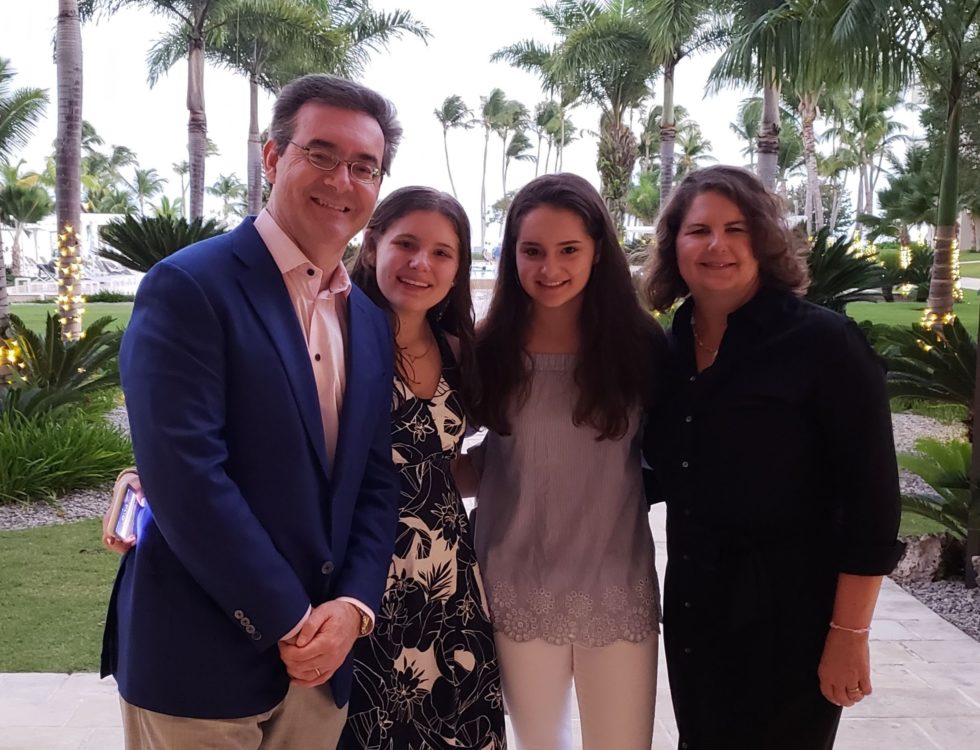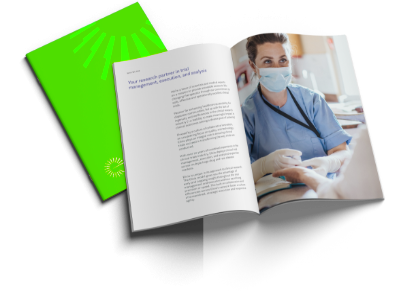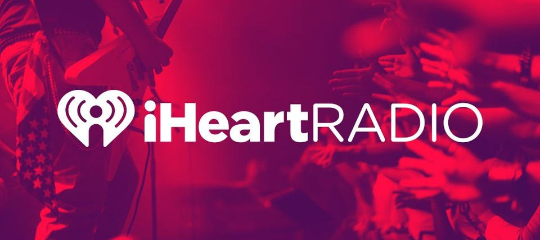
- Blog
- Mar 23, 2022

Photo: (L-R) Pierre and his family, daughters Sophia and Isabella, and wife Mary Rosser.
Podcast Transcript: Pierre Riffs on the Audio Industry, Attribution, Marketing Performance, the Importance of Creative, and More
As the Chief Insights Officer at Cumulus Media | Westwood One, in addition to being President of the Cumulus Media | Westwood One Audio Active Group®, Pierre Bouvard has his pulse on the audio industry.
Having started in radio in college, and by interning at local radio stations, he was bit by the data bug early on, adopting a keen understanding of what radio ratings meant and how stations could use those to their benefit. Program directors looked to Pierre to improve their ratings and improve their brand, and he trained radio sales teams on how to use radio ratings data.
After his own stint in audio sales and marketing, he now oversees insights for the Westwood One’s large radio network and the Cumulus Podcast Network.
Pierre recently joined host Lucas Sommer on the Attribution Marketing Podcast to talk about the audio industry and its move over the last half decade-plus to better measure the impact radio, streaming audio, and podcasting advertising provides to marketers, brands, and agencies.
Give the episode a listen or here’s a near-full transcript:
Lucas:
How has audio marketing or using broadcast audio grown up over those years? You listed off a bunch of technologies in different formats, but walk us through that evolution of the space itself as opposed to maybe your career.
Pierre:
“Yeah, I think for, I think there’s been more change in the last seven or so years in audio’s ability to measure itself and to prove impact…And so for the first time in since 2015, radio has been able to match what people listened to to what people buy and that can be useful for targeting, for finding the right audience or actually measuring impact.
“The other kind of big innovation is what you guys have brought to audio, and that is attribution. You know, for years, marketers have been asking, can I quantify if audio ads, whether its streaming podcasts or radio can drive search and site traffic. And it really wasn’t until LeadsRx came on the scene that we can confidently now do that. So that’s been a major kind of shot around the world for audio, the ability to kind of connect the dots between radio ads and search and site traffic.
“And I think the other major innovation is there’s a lot more brand lift measurement going on across all of the various audio platforms, whether it’s streaming podcasts or radio, where we can show how radio can build brand equity. It’s almost like before 2015 and after 2015, it’s been a huge revolution in attribution and measurement for audio.”
Given all the new tools, what attribution’s been able to do, now that you have access to all this data, what are the most important data points that marketers should be looking at now that they have access to all this?
“What’s interesting is for the most part, a lot of folks in advertising look at the world through the lens of media. And they’re under the false assumption that all of the results and the impact are really having to do with levers in media, meaning what day I run, what time I run, how long is the ad? How short is the ad? How often I run the ad.
“What we have found and a lot of other much smarter people have found who specialize in marketing effectiveness is the single most significant driver to sales effect is not media, it’s creative. 50% to 70% of the results of your campaign have to do with the creative, and so what attribution has allowed us to do is actually turn the focus away from media and a lot of the what I would call very small levers (you know like how long is the ad and when do I run it) to the big lever of creative and say which creative asset is really driving search and site traffic for me.
“And one example I’ll give is we had a national jewelry chain that was running seven different pieces of copy on the radio throughout the country. And we found, through the LeadsRx data, one of the seven campaigns represented maybe 10 or 15% of the impressions, but 25% of all the site traffic. And this happened to be an offer, which was you know, you spend over $200 and you get a big store credit.
“So this offer was powerful. And so that allowed us to go to the brand and say, you know, you need to shift over more to this specific creative. So I think the big ‘aha!’ is that creative really dominates impact and the power of your creative has so much to do with how well your marketing is working.
“And so what then that leads you to ask the question is, maybe I should be pre-testing my creative. If creative generates 50 to 70% of sales effect, maybe I should be testing my creative in advance. And so one of the things we’re doing, I have a team called the Cumulus Media | Westwood One Audio Active Group®, and we’re like a consultancy for brands and marketers, is we do a lot of creative testing for brands. We do creative testing for P&G and a lot of other marketers because creative is so important to creating impact for your business.
So talk us through that. What do you mean by pretesting that creative? It makes sense on the surface. Just how you’re using those words, but mechanically or logistically, how does that play out?
“So there are firms out there that specialize in pretesting creative, like ABX and Veritonic; they recruit a group of consumers who fit the target audience of the retailer or the brand. So if it’s young women, older men, whatever. So they recruit a group of people and then they expose them to a number of different ads that the company wants to get a read on. And there’s a series of questions: purchase intent, brand favorability, purchase consideration, likeability.
“These are standard questions and these companies, because they’re testing literally thousands of different creatives from many different companies, they have norms and benchmarks, so they can tell you how strongly persuasive this particular ad was; how strong is the branding in the ad? They also do something called 48-hour recall where after they pre-test the ad with a consumer, they reach back out to them 48 hours later and ask them a series of questions to see how memorable your ad is, because memory and memorability is what drives someone to search for your brand or search for your store.
“Each ad is benchmarked against category averages. So for example, if you’re an e-commerce site in the clothing industry, you can see how does my ad score against similarly situated companies. And the idea is before you spend your media money, make sure that the creative is memorable, it resonates, it has strong purchase intent.”
“So there are special companies that this is all they do. And, you know, it’s probably the single most important thing you can do before your campaign begins to ensure that your ads are really going to perform.”
What should a new advertiser do if he or she has a half-million dollar budget and is looking to launch a campaign or try a new format; how much should be spent on creative testing?
“The more important question is how much are you going to spend on creating the creative. If you take the world of podcasts, every ad sounds the same. It’s a very dry, rational fact-filled read.”
“A couple of major decisions have to be made about the creative and the more money you spend on the creative, the more likely you are going to have a better effect. So the first question is rational versus emotion-based. Emotion-based ads that make you feel something are far more likely to draw greater sales and greater profit than ads that are just a laundry list of rational facts. You want ads that are memorable. There is something in creative circles called a fluent device. That’s either a memorable brand character (or slogan). I think of the Geico gecko or Progressive’s Flo that instantly make people think of those brands.”
“The fluent device could also be a situation like Snickers. You’re not yourself when you’re hungry. So the more important question is let’s get a good creative agency and let’s really let them work on a campaign that is memorable, that breaks through. That creates emotion. So that’s the most important decision.
“Because look, if creative is 50 to 70% of marketing effect, you need a good creative agency to really create impact. And people that are listening to this in B2B will think to themselves, oh, that’s not for me. You know B2B is just, you know, facts and figures. The smart B2B brands are realizing that all of these rules of marketing effectiveness apply to them. So look at Salesforce, they have a fluent device. They have that little bear or that little koala that you see in all their ads. That’s their version of Flo.
“So, good creative agency, and then depending upon how many assets you have. It’s not very expensive to pre-test creative, you know, it could be five to $20,000. So that’s the small cost. The bigger cost is making an investment in really, you know, powerful and quality creative.”
Question: LeadsRx has a mantra that People + Data = Better. There is tons of marketing analytics data available, but do you think bringing people into the equation makes things better or worse?
“Oh, I think you absolutely need to bring people in into the equation. And let me give you a lesson right out of LeadsRx. So you could, in audio, analyze the data and say, oh, you look at this time period nights, we had an extraordinary lift for my ads that ran at night. So if you just, you know, turn the machines on, the machine might say, any time period where I have very high conversion lift, let’s just put more money there.
“A human will say, whoa, hang on, in the radio world most of the listening happens during the day; almost 70% of listening happens between 6 a.m. and 7 p.m. Nights, while it’s primetime for TV and video streaming, it’s actually smaller (for radio) with only about 10% of or 8% of listening happening at night.
“So if the machine is just chasing the high lift, you know, it’s going to put more and more money at night when there’s not a lot of people that are actually listening versus other time periods. And then a human will say the reason maybe why we have a lot of conversion is because audio and radio is the soundtrack of the American worker. The vast majority of American radio listening occurs among people that have a job and therefore they’re busy, and so actually nights is a time period where they have some time, they have their phone, they have a laptop, they’re on the couch, so they actually have more of an opportunity. To go hit that website.
“And so the human has said, as we do all these LeadsRx studies, remember you always will see a high over-index at night, but don’t overreact to that. Don’t think you’re going to move all your media at night. The reason why you’re doing well at night is because you were hitting people frequently and often, and lots of people during the day, and when they had the opportunity to go online, that was at night. That’s where I think a human can look at context and not go chase, you know, a high index blindly.”
Other helpful links:
- Radio Online article: Radio Generates Significant Auto Dealer Website Traffic
- Pierre YouTube video: Interesting Insights on Marketing Effectiveness and Attribution That Can Really Power Local Auto Sales
- Downloadable Joint iHeartMedia/LeadsRx Study: 5 Secrets of Automotive Advertising Report
- Visit the LeadsRx Attribution Marketing Channel for more content: https://www.youtube.com/channel/UCY2b_yr1M3cB8IGV7RSZwhA
How has your experience helped you as you take on new clients or bring people into this space? What are some of those tips or tricks that you’ve been able to use to advise people as they’re getting started?
“Because I worked for a market research company, I learned early on at Coleman that the awareness of a business is what drives usage, and the images and perceptions of that business is what keeps people coming back. And what that has taught me is that when we’re looking at attribution data, the kind of immediate reaction is, oh, what were the tactical things that we were doing in this campaign? Was it the color, you know, was it the ad unit, and what all of the marketing effectiveness research says is that really what drives performance is the brand and brand-building.
“And in fact the vast majority of the lift and the search and the site traffic comes from the upper funnel. There’s a reason why the upper funnel is so big awareness consideration, brand favorability, because that’s where the results come from. So I think my history of being able to do brand studies across different categories has really taught me that you have to be known before you’re needed.
“The person that is searching for you today, learned about you sometime in the past and not everybody is in the market for whatever you’re selling. And so you have to be really building long-term brand awareness and consideration before you’re going to turn that person into a customer.
“I think the other thing that experience has taught me is that marketing and advertising is a long-term game. There is a major media mixed modeling company out of the UK called Gain Theory. And they did this huge study where they looked across many brands, many industries, many countries, and they came up with the 18-24-58 rule. And what it says is if you look at the marketing investments you’re making this month, 18% of those investments will have an effect this month. So that’s the kind of stuff that you’re measuring with LeadsRx. 24% of this month’s investment is gonna show up between month two and month five. So that’s kind of what you’re doing today, 24% of it, actually, more of what’s impacting short-term is going to impact in the medium term two to five months. 58% of this month’s marketing investments have an effect six months and beyond.
“So what you realize is that with attribution, you’re only measuring a very small percentage of your marketing investment impact that’s happening in the short term and the majority of your marketing dollars are impacting long-term and therefore you have to take the mindset of, okay, most of what I’m spending this month, and most of what I’m saying in ads, is probably going to take a year or two to actually have an impact. And so I need to actually focus more on the people that are in market in two months, six months, and 12 months, and really work hard at building brand images and brand equity and strong and favorable feelings about the business, as opposed to being so anxious about what’s going to happen to this.
“So there’s a gentleman out of the UK, Aidan Mark, who works for VCCP, a major London media agency, and he put out a piece called ‘Is your performance media really driving all of the performance?’ And we have a link to that piece in the show notes (see hyperlink above), but he brings up kind of 10 key points that really helped performance marketers understand that there’s really a lot of impact that’s coming from the brand itself and the brand and marketing that is really what’s driving a lot of the performance.
“And one of the nuggets that I’ll just offer for you that he says is that famous and desirable brands have lots of searches for their brand and products. These keywords come at low costs and with a high purchase intent. So fame and awareness of the brand and the strength of the brand really drives so much impact for performance marketers. So it’s a great piece. It’s a short piece. I highly recommend people give it a read.”
I wanted to ask you just to describe maybe some of the challenges, or maybe they turned into opportunities, that the pandemic presented for this business, the data, just in general, your world of audio advertising and attribution. And then, just as a follow-up part two, where do you see the industry headed or going as a result of coming out of the pandemic or just going into the future with privacy and technology and all that. So there’s probably seven questions baked into all of that. But if you will, just talk through the challenges and opportunities, the pandemic faced, and then where you think the industry is going.
“Yeah. So the pandemic and the impact on radio listening was very short-lived. We did see in April and May 2020 a pretty short term, but significant dip in radio listening as America was pretty much sheltering at home.
“But that went away in about 60 days. The pandemic was primarily a major market affair. When you look at miles traveled was really hit the most in our biggest cities, like top 10 markets, top 25, and that recovered pretty quickly. So I think the biggest impact of the pandemic mostly was marketers and advertisers who were sheltering at home and thought everyone else in America was doing what they were doing.
“And one of the biggest rules of radio is you have an audio and media, and you have to take the me out of media. Don’t take your personal media habits and project that onto America because people that are in media and marketing are not like America. We’re very different. We have very different media habits.
“And so there was this myth that we were encountering where people said, you know, gosh, I’m at home, so therefore everyone in America is at home. So therefore nobody’s listening to radio. The good news is hard data helped correct these misperceptions. The Federal Reserve is publishing monthly commuter studies that show the vast majority of Americans returned to work about a year and a half ago.
“You know, the impact of the pandemic was more perceptual about radio than actual. In the world of podcasting, the pandemic helped accelerate what has been an already accelerating usage of podcasting. The gold standard kind of audio time use study is called Share of Ear. It’s published every quarter and we just took a look at pre during and post pandemic.
And you absolutely see that the pandemic took what was a growing podcasting ad medium and just put gas on the fire and it really accelerated. And in fact podcasting is actually crushing music streaming. So if you look at the two biggest players in audio streaming, Pandora and Spotify, there’s actually more audience to podcasting than ad supported music streaming on Pandora and Spotify.
“So that has really caused a big shift in usage where basically. Music streaming services that sell ads, their audiences actually were higher four years ago than there were today. Podcasting on the other hand is going absolutely through the roof.
“The other mega trend that I think was accelerated by the pandemic was streaming to radio stations. There’s actually as much or more streaming to AM-FM stations than there is to Pandora and Spotify. And the last two years has seen a significant uptick. Radio’s the soundtrack of the American worker. If people were working at home, therefore streaming and streaming audiences have been growing dramatically. A couple of years ago, about 8% of all American radio listening occurred through the stream. It’s now 14%. So it has really grown pretty dramatically.”
So how about this one for you? You know, my own experience on social media or just consuming content, content continues to get shorter. Even the ad units, Facebook and Google, they’re starting to shorten everything. And yet podcasts are getting longer it seems, and people are willing to consume that content. So how is it, that on the two tails of the spectrum podcasting versus, I don’t know, social media ads, it seems like the shorter is getting shorter, but the longer is getting longer? I don’t even know how to phrase that question, but what do you see?
“It’s a great observation. We just published a couple of weeks ago a study and it’s on our blog. We actually looked at a IAB study that was conducted in 2018 that asked Americans, how much are you concentrating when you’re listening to a podcast or when you’re on social media. And this study from four years ago, said the media where the least concentration, where people are paying least attention: social media. The media that people are spending the most attention: AM-FM radio and podcasts.
“So with social media, they know people don’t pay attention to the ads. And okay. What do we do to try to make these ads noticeable, maybe we’ll do more of them. Maybe we’ll make them shorter. So there’s kind of a frantic attempt in social media, knowing that people don’t pay a lot of attention to social media ads, to try to do something, tricks, gizmos, gadgets, to try to, you know, get people to pay attention.
“The need state of audio for radio is about connecting. It’s about a personality and people that get me to work. So there’s a humanity there. And when we ranked out all of the media in this study that has the most amount of ad skipping, not surprisingly, it’s all digital: social, popups banner ads – huge amounts of skipping. Media that people skip the least, meaning that our most sticky, AM-FM, podcast, print – it’s all traditional media or audio.”
Yes, to answer your question, people pay a lot of attention to the ads and podcasts because one of the needs states in podcasts is to learn something. Think about that: to learn something. If you want to learn something, you are paying attention, you are leaning forward, you know, and that’s why podcast ads work so well because they’re sitting in this content that people are getting information.
Yes, they’re being entertained, but they’re learning something. So that’s why podcasts ads work so much better than social media.”
Interested in being a guest on the LeadsRx Attribution Marketing Podcast? Email cam@leadsrx.com.





